July 31, 2024 – Volume 26, Issue 7
In This Issue
- Flanigan’s Net Positive: Linking High-Speed Rail
- ZIPs and ZEVs
- Hemp: A Climate-Protection Superstar
- South Australia Nears 100% Net Wind and Solar
- Linear Generators
- San Francisco’s Hydrogen Fueled Ferry
- Corryong Community Microgrid
- Thermal Energy Networks
- Sodium Batteries
- RECs 2.0: Arbitrage
- Flanigan’s Eco-Logic Podcast Updates
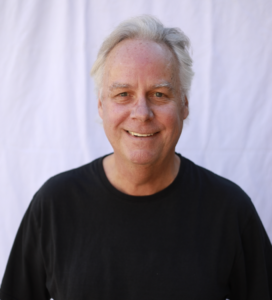
Flanigan’s Net Positive: Linking High-Speed Rail
Most Americans have no idea that high-speed rail is coming to California. Actually, it is being built. And now, imagine this: There is not just one, but two, high-speed rail projects coming to Southern California. One is the California High-Speed Rail. It will link Los Angeles and San Francisco and is slated for completion in the 2030s. Many sections will be operational long before then. The second is Brightline West, a rail line being built to whisk passengers from Los Angeles to Las Vegas. It is expected to be fully operational by 2028.
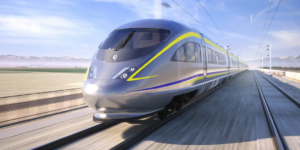
Now the two high-speed, all-electric systems will be linked through a section of tracks called the High Desert Corridor. Members of the High Desert Corridor Joint Powers Agency signed a community workforce agreement and a memorandum of understanding… creating thousands of jobs, smoothing construction, and preparing for operations and maintenance of the 54-mile transit corridor. The first phase will connect Palmdale and Victorvile. Later it will connect to the California High-Speed Rail Authority (CHSRA) and Brightline when those lines reach their destinations.

Meanwhile, in late June there was a major milestone in the quest to link the State’s two major population centers. The CHSRA finalized the environmental approval for its Los Angeles to San Francisco project… considered a historic milestone in a state notorious for holding up construction for environmental review. The Authority’s Board of Directors approved the environmental impact report and selected a route between Palmdale and Burbank… the last segment of the intercity route that had yet to be environmentally cleared.
The last segment has been considered to be among the most challenging to build. It requires boring long tunnels through some of the most mountainous terrain along the entire route. The longest tunnel coming into the Los Angeles area will be 13 miles long. The 38-mile segment approved by the Board has 30 miles of tunnels, 28 of which travel through mountains. Part of the route will be along Highway 14, separated from vehicle traffic, and exclusively used for high-speed rail.
Quote of the Month
“.. China is positioning itself to command the next big innovation in rechargeable batteries: replacing lithium with sodium, a far cheaper and more abundant material.”
ZIPs and ZEVs

Nothing to do with the Post Office, this is all about carbon. ZIPs are Zero-emission Vehicle Implementation Plans. They are the result of detailed analysis and planning, including community engagement. They are all about making sure that there is and will be sufficient electric vehicle charging and hydrogen refueling infrastructure to meet clean transportation goals for Zero-Emission Vehicles (ZEVs). They are also known as ZEV Action Plans.
ZIPs carefully document existing conditions. They forecast transportation demands. They describe near and longer-term actions to be taken by governments in collaboration with the private sector to meet the needs of the growing ZEV market. ZIPs chart next steps in equitable ZEV and infrastructure deployment. The ZIP planning process features community discussions of needs, growth, and collective problem-solving. ZIPs are intended to be updated every two years.
California’s goals include the target of having 1.5 million ZEVs on the road by 2025. That was codified in Executive Order B-16-12. It was followed by a goal for there to be 5 million ZEVs by 2030 (EO B-48-18). The State intends for 100% of new vehicle sales to be zero emission vehicles by 2035. This includes passenger vehicles, light-duty trucks, off-road vehicles, and equipment… “everywhere feasible.” By 2045, 100% of all operating medium and heavy-duty trucks and buses are to be zero emission vehicles.
California’s Zero-Emission Vehicle Market Development Strategy cuts across all sectors, presenting policies and programs to drive down transportation emissions. Public, private, and utility investments have played roles in deploying ZEVs and the charging/refueling infrastructure.
Public funds have been used to accelerate deployment, while ensuring equitable outcomes. California has allocated a historic level of $10 billion over five years to accelerate zero emission vehicles and infrastructure deployment. Part of the State’s funding commitment is fulfilled through electric ratepayers: The California Public Utilities Commission authorized $2.85 billion spending by the six investor-owned electric utilities that it regulates.
The State has also been funding research on emerging technologies, like battery swapping, wireless charging, and mobile charging units.
Hemp: A Climate-Protection Superstar

Some say that hemp is a key tool in the fight to minimize the impacts of climate change. It is a biogenic material produced by growing plants. Like all plants, it absorbs CO2 from the atmosphere, locking it in carbon fibers… in this case in hemp plants.
Hemp farming began 10,000 years ago. Hemp was prominent and routinely used for rope and for shipbuilding. It was used for textile production. It was legal in the 18th and 19th centuries. But due to its connection to marijuana its production was banned in the 20th century, a function of the war on drugs and the Controlled Substances Act of 1970.
Hemp is a variety of cannabis sativa. So is marijuana which has a strong concentration of THC, the active ingredient. There is a tiny amount of THC in hemp and that was at the root of its demise. For nearly 50 years, hemp production was illegal in America… considered a controlled substance.
In 2017, the U.S. government removed hemp from its list of controlled substances. Hemp returned as a legal crop with the restriction that the THC concentration can be only 0.3% on a dry-weight basis. It is still controlled in the United Kingdom.
Today, hemp has many uses. It is used in clothing. Raw hemp fiber is made into panels and mats for thermal and acoustic insulation. It is made into hemp lime… mixing raw fibers with mortar and molding it into blocks that can be substitutes for concrete blocks, even in load-bearing walls.
One of its greatest virtues of the day is that hemp is climate friendly. Hemp grows much faster than trees, up to 12 feet within four months. Hemp absorbs twice as much CO2 as trees. Thus hemp is a great carbon sink. A hectare of hemp can sequester up to 22 tonnes of CO2e a year. Trees sequester 6 tonnes of CO2e per hectare. Can it also be a solid income generator for farmers? Florida A&M University recently received a $4.9 million grant from the USDA Climate-Smart Commodities program. Researchers are looking for ways to support hemp production.
Hemp is good for soils, enhancing activity of microorganisms like fungi and nitrogen-fixing bacteria. Its deep roots help to aerate the soil, prevent erosion, and enhance soil structure and fertility. It is naturally resistant to many pests and diseases… thus can be grown with less pesticides. Through phytoremediation, hemp absorbs some heavy metals in the soil, detoxifying the soil. Hemp requires less water than other crops thank to its deep roots. For textile production, the water footprint of cotton is three times that of hemp. Thus hemp is the sustainable choice especially in areas of drought or water scarcity.
You can eat hemp too. Hemp has a high concentration of fiber. It contains Omega-6 and Omega-3 fatty acids. Hemp seeds are actually nuts. Hemp hearts are the inside of the seed, some people prefer the taste and softer texture of the hearts, perhaps like wheat germ.
Hemp is a superfood. By weight, hemp seeds have almost as much protein as soybeans… and a typical serving provides more protein than an egg. Three tablespoons of hemp seeds provides 9.47 grams of protein. Comparatively, an egg provides ~6.5 grams of protein. Hemp is a complete protein with all nine essential amino acids. It boosts heart health and improves skin conditions and joints.
South Australia Nears 100% Net Wind and Solar

Renew Economy reports that South Australia has locked in federal funding through what’s known as the Renewable Energy Transformation Agreement. The government there will underwrite 1 GW of solar and 400 MW / 1,600 MWh of energy storage to ensure that South Australia meets its 100% renewable energy target by 2027. With these additions, it will be the first grid in the world to reach 100% net wind and solar.
Currently South Australia leads the world with a solar and wind share of 70%. This has been enabled by new capacity and the New Project Energy Connect transmission link from New South Wales. This year, new 412 MW Goyder South wind farm, plus several new battery projects, will advance South Australia to 80% this year. Note that 80% is a net number; it is not a 24*7 value. The State will export power at times, and import at other times. Its utility can fall back on peaking gas plants to fill gaps in its supply.
South Australia is a renewable energy pioneer. It has advanced its renewable energy target by three years… now 100% by 2027. Meanwhile there has been controversy about a defunct coal-fired power plant. Some want to convert it to nuclear. But it is now serving as a hub for green energy and green industry. South Australia is also building the world’s first green hydrogen power plant at Whyalla. It will be accompanied by a 250 MW hydrogen electrolyzer and storage facilities, the world’s largest such facility.
The Australian national government’s Capacity Investment Scheme plans to contract up to 32 GW of generation and storage capacity around the nation, to reach 82% renewable power by 2032.
Linear Generators

Image Courtesy of Mainspring Energy
Heard of them? They were called “free piston linear generators” for some time. Recently, the technology has been advanced by Stanford scientists/engineers. Now a new venture, Mainspring, is staffed by an exciting team, some of whom shifted over from Bloom Energy and its fuel cells.
How cost-effective are linear generators? What are their benefits compared to rotary generators, compared to fuel cells? How do they stack up in terms of carbon? EcoMotion had done a similar third-party technology assessment for a college for fuel cells some years ago. This time we dug into linear generators.
Most generators are rotary. But not linear generators: Each cylindrical linear generator core consists of a reaction chamber, two oscillators, two stators, and two air springs. Where a gas-fired turbines use combustion reactions to impel movement, linear generators use a low-temperature chemical reaction. This low-temperature chemical reaction is produced by an increase in pressure in the reaction zone, rather than ignition by flame.
Fuel and air enter the reaction chamber via ports, air springs on the outer edges of the apparatus push oscillators toward the center of the reaction chamber and through the stators, and once a threshold pressure is met, a chemical reaction occurs, rearranging molecules. This chemical reaction pushes the oscillators outward, away from the center of the reaction zone, until they encounter sufficient pressure in the air springs to make them return to the center of the device, completing the cycle. Electric current is produced by the side-to-side movement of the oscillators. These oscillators house magnets and pass through magnetically charged cylinders which are equipped with copper coils and act as stators.
Fuel and air enter the reaction chamber via ports, air springs on the outer edges of the apparatus push oscillators toward the center of the reaction chamber and through the stators, and once a threshold pressure is met, a chemical reaction occurs, rearranging molecules. This chemical reaction pushes the oscillators outward, away from the center of the reaction zone, until they encounter sufficient pressure in the air springs to make them return to the center of the device, completing the cycle. Electric current is produced by the side-to-side movement of the oscillators. These oscillators house magnets and pass through magnetically charged cylinders which are equipped with copper coils and act as stators.
The benefits of linear generators are multiple: They are relatively small and can serve a building’s load 24*7. Unlike fuel cells, they can follow loads. They can run on a variety of fuels… and in the future, they will run on green hydrogen. Our solar team modeled their use, drawing load profiles from three proxy sources. The financial savings are fantastic. Our analysis using a number of load profile scenarios for the specific application analyzed, showed that the deployment of two units at the new facility would save millions. And they can provide resilience in the event of a grid outage.
We found that when today’s linear generators run on natural gas, they produce nearly 1,100 lbs of CO2 equivalents per MWh. This is on par with similarly sized natural gas reciprocating engine generators. Fuel cells report emissions of 883 lbs CO2e per MWh. California’s utility average CO2e emissions is 422 lbs per MWh, less than half of the linear generator value. So while linear generators have great savings potential, using natural gas, they come at a stiff environmental cost.
Then a fascinating assignment: Could the deployment of linear generators provide both a net positive economic benefit and a net positive environmental benefit? Is there a win-win at hand? Yes, it is plausible. The key is offsets, credible offsets. Through an offset approach that blends community offsets with out-of-state/out-of-country offsets, big economic savings can be had, and so can environmental savings in which the community can be proud.
Some may criticize the use of offsets, and the voluntary purchase of offsets. In voluntary markets, offsets need not be certified. EcoMotion recommends to its clients that if this strategy is employed, that high-value offsets are purchased or at least heavily blended. These are verified by third parties, allaying concerns of fraudulent claims and failed additionality.
EcoMotion is about to release a white paper on linear generators. Please let us know if you’d like to learn more and receive a complimentary copy of our report on linear generators slated for release in August.
San Francisco’s Hydrogen Fueled Ferry
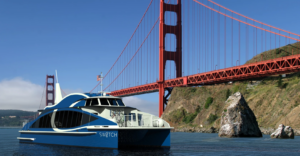
Image Courtesy of SWITCH Maritime
It’s a 70-foot catamaran. It can carry up to 75 passengers. This month (July 19th) the ferry began providing a free shuttle service between Pier 41 and San Francisco’s Ferry Building. The new ferry can operate for up to 16 hours on a tank of hydrogen fuel, traversing as many as 300 miles. The service will be free for six months. It is touted as the world’s first hydrogen-powered commercial passenger ferry.
The name of the vessel is MV Sea Change. Its development and construction was financed by SWITCH Maritime. Its hope is to prove that hydrogen is a viable fuel for ferries in the Bay Area and beyond. The San Francisco Bay Area Water Emergency Transportation Authority provides commuter vessels around the Bay Area. MV Sea Change has fuel cells on board that combine hydrogen and oxygen and emit water as a byproduct.
The intent is to demonstrate one means of transforming the shipping industry which is responsible for ~3% of global emissions. The International Maritime Organization has a goal to halve shipping emissions by 2050. Hydrogen may be one means to do it. There is ~$8 billion in federal stimulus money targeted at figuring out how to produce and deliver clean hydrogen.
Corryong Community Microgrid
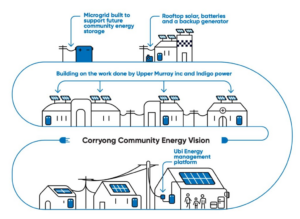
Image Courtesy of Mondo Power
Corryong is about 75 miles east of Wodonga in northeastern Victoria, Australia. It was among the Victorian towns hardest hit by the 2019 – 2020 Black Summer bushfires. Since then, Corryong has been in serious search of energy resilience. Soon, its 900 homes will be able to self power themselves thanks to a microgrid that will help keep the power on during bushfires and storms.
The system will power homes as well as businesses and community facilities during a utility network outage. At those times, when an upstream network encounters a fault, the township will disconnect from the network and will fully rely on the microgrid battery. It, in turn, will be powered by diesel and rooftop solar for ongoing operations. Thanks to its 4.99 MW / 5.2 MWh battery, Corryong will have an “island-able microgrid.”
The system is designed to provide resilience in the form of power for up to five days. This is done using the battery with three generators. Excess solar will power the battery as well. The centralized battery and controls will connect 33 residential solar + storage systems. The residential systems will be installed with a smart energy management device known as the Mondo Ubi… allowing the system to be integrated with the microgrid and virtual power plant initiatives.
The microgrid relies on participation: A limited number of solar and battery systems were offered to Corryong residents. Expressions of Interest were then submitted in January 2022. Also included in the project is the installation of a solar system, battery, and diesel generator at the Corryong Police Station.
Funding for the $28.6 million project has come from the federal government’s Disaster Ready Fund, AusNet, and the Victorian government. The project is an expansion of the Community Microgrids and Sustainable Energy Program which has funded resilient energy systems in 26, high-risk towns.
Meanwhile, the Western Australia government’s first renewable hydrogen microgrid was commissioned early this year., Microgrid Knowledge reports that the government and Horizon Power, the primary power producer in Western Australia, have released a report of their findings. The “Public Commissioning Knowledge Sharing Report” confirms the great opportunity for hydrogen to plan a role in the State’s energy transition. This according to Acting Energy Minister Tony Buti.
The Denham Renewable Hydrogen Microgrid is made up of a 704 kW solar farm and a battery energy storage system. It includes a 348 kW electrolyzer and a 100 kW fuel cell. Its developers point out that the system does not use an inordinate amount of water… about the amount used by four typical households. Meanwhile, the microgrid will offset 37,000 gallons of diesel each year and will produce enough energy to power 20% of Denham’s homes and businesses.
Horizon has a 1.4 million square mile service territory. Much of it is remote. Horizon has built three dozen microgrids and now will be taking over 117 microgrids from the Western Australia Department of Communities. One of its goals is to show that hydrogen energy storage systems are viable alternatives to diesel-powered generators, what it calls the “time shifting of power.”
Thermal Energy Networks
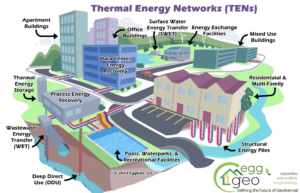
Coming into my focus are thermal energy networks. Like district heating systems, thermal energy networks link users in a community system. They are a means of networking renewable systems, notably ground-source heat pumps to serve a community of loads. Each building taps into the network loop.
The Building Decarbonization Coalition introduced me to this term. Thermal Energy Networks (TENs) are “neighborhood-scale systems that use underground pipes to exchange heat with buildings and energy sources.” Waste heat can also contribute to TENs; it can be recovered from industries and sewer systems.
Think of this as “networked geothermal.” Instead of serving a single load, TENs link sources and loads in communities. Thirteen states are now implementing policies and programs for underground thermal energy networks to reduce buildings’ carbon emissions. These include Massachusetts, New York, Illinois, New Jersey, and Colorado to enable efficient, fossil-fuel-free heating and cooling.
Framingham, Massachusetts is the site of one of the country’s first geothermal network pilot projects. Eversource, the utility there, has completed 70% of the pipe installation for its Eversource Geothermal Pilot Program, a project that will serve residential, business, and municipal facilities. The planned route of the network loop consists of 36 buildings, 24 of which are residential homes.
In 2020, New York State mandated that its largest utility companies design Thermal Energy Network projects with guidance from the Public Service Commission there. Consolidated Edison is planning to link two public housing buildings with a nearby data center in New York’s Chelsea neighborhood. Waste heat from the data center will provide the buildings’ heating, cooling, and hot water.
TENs provide stability, powered with geothermal energy and waste heat sources. They are also seen as a new opportunity for professionals in the fossil gas industry. An article in the MIT Technology Review notes that, “A 55-year old pipe fitter cannot become an offshore wind technician.” But instead of maintaining a network of lines to move natural gas, workers can now craft networks of thermal energy pipelines for renewable resources. At Eversource, managers see TENs as a new service that the utility can provide.
Sodium Batteries
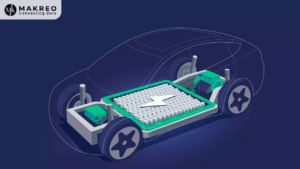
Ions are particles with positive charges. Sodium-ion batteries use sodium-ions instead of lithium-ions to store and deliver power.
Sodium is much more abundant and environmentally friendly than lithium. Sodium is safer; it’s less prone to overheating and catching fire. But, it has a lesser power density. We’ve reported on sodium before, and will again!
Sodium batteries are cheaper to produce given the abundance of sodium on Earth. Sodium sells for 1 – 3% of the cost of lithium and is chemically very similar.
Given its power density, lithium batteries pack a bigger punch… meaning they deliver longer ranges. But sodium batteries also have a big advantage: They keep almost all of their charge when temperatures fall below freezing, something that lithium batteries typically do not do. CATL has been experimenting with mixing lithium and sodium in batteries, to get the best of cold weather and long-range operations.
Sodium batteries have the potential for similar energy density as lithium batteries. While researchers say that, “they aren’t quite there yet,” they are in production. The Chinese company HiNa has partnered with the state-owned Three Gorges Corporation. The partnership has started mass production of sodium-ion batteries. Its first-generation of sodium batteries offers energy densities of 125 Wh/kg, half that of lithium-ion batteries. The next versions are expected to have energy densities of 200 Wh/kg, nearing the typical EV battery today of ~250 Wh/kg.
Research on sodium batteries began in earnest in the 1970s in the United States. Then Japan advanced the technology. Chinese companies have taken the lead in commercializing the technology. Out of 20 sodium battery factories worldwide, 16 are in China. China will have 95% of the sodium battery production by 2025.
Sodium-ion batteries may be well suited for utility applications. Some Chinese provinces are requiring solar and wind farms to store 10 – 20% of their generation… making low-cost sodium batteries an appealing option where space and weight are not concerns. Sodium batteries also make sense for limited range, low-cost EVs.
Where to get the sodium? Soda ash is the preferred source and main industrial source of sodium. Soda ash, technically sodium carbonate, also known as washing soda and soda. The U.S. accounts for over 90% of the world’s readily mined reserves of soda ash. It is found deep under southwestern Wyoming. Near Green River, there’s a vast, underground deposit of soda ash – technically “trona” or trisodium hydrogendicarbonate dihydrate. It was formed 50 million years ago. It has been extracted for years and is currently used for glass manufacturing. There is a similar major natural reserve and now trona mine in Ankara, Turkey.
China has minimal soda ash natural reserves of soda ash, so it produces synthetic soda ash at chemical plants fueled by coal. This process has resulted in hazardous water pollution, in 2016 fouling a major river.
RECs 2.0: Arbitrage
Consider these statements: “Our facility is home to an onsite solar array. We are using renewable electricity.” Both are true. And both are carefully crafted, clearly articulated, because they illuatrate a scheme called “REC arbitrage.”
Every megawatt-hour of electricity generated by a renewable source earns a REC, a renewable energy certificate. The RECs can be stripped away from the power commodity, and sold separately. Who wants to buy RECs? Someone who wants to claim to be using renewable energy.
Back to the statements. The facility does have solar on its roof. But it sells the solar system’s RECs for $5 each. It then buys RECs from different renewable energy facility for $3 each. The owner walks away with a $2 profit for every REC transacted.
While the owner’s premium $5 RECs were sold, and replaced with lower-quality RECs, the facility indeed still holds RECs. And as a REC owner, the facility has the exclusive rights to make claims about “using” or being “powered with” renewable energy associated with that REC.
That’s REC arbitrage and the ability to brag legitimately, within the Federal Trade Commission rules. That said, EcoMotion advises clients to retain their RECs.
Flanigan’s Ego-Logic Podcast Updates
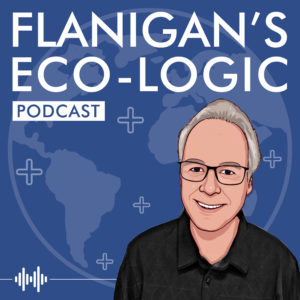
Use the links below to check out our recent podcasts. And you can always go to Spotify and type in “Ted Flanigan” to find our library of podcasts.
Recently Released:
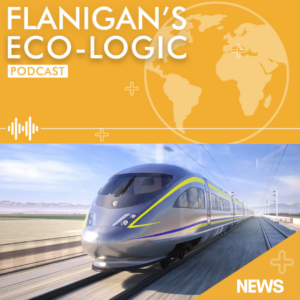
In EcoNet News, Volume 26, Issue #7, Ted highlights two high-speed rail projects coming to Southern California: the California High-Speed Rail, linking Los Angeles and San Francisco, and the Brightline West, linking Los Angeles to Las Vegas. He also highlights ZIPs (zero-emission vehicle implementation plans) and ZEVs (zero-emission vehicles), the climate-protection superstar hemp, South Australia nearing 100% net wind and solar, linear generators, San Francisco’s hydrogen fueled ferry, Corryong in Victoria, Australia’s community microgrid, thermal energy networks (TENs), sodium batteries, and renewable energy certificate (REC) arbitrage.
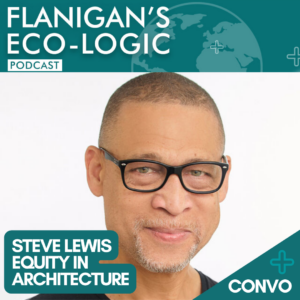
In this episode of Flanigan’s Eco-Logic, Ted speaks with Steve Lewis, Urban Design Principal with the Portland-based firm, ZGF Architects. Steve was also a candidate for the 2026 President at the American Institute of Architects (AIA). He is a facilitator of partnerships and alliances between groups and individuals who seek to use architecture and design to effect positive change to our world.
Steve brings to ZGF a wealth of experience across urban planning and design, from Southern California to Detroit and back, Steve’s ethics-driven urban planning and design has made the cities he’s worked in not only more aesthetically beautiful, but also more equitable and representative of the surrounding communities. Following in the footsteps of his father, an architect with a drive for justice, equity, diversity, and inclusion, Steven designs, speaks, mentors, and volunteers tirelessly to advocate for what he believes in and to see those values embodied in the built environment.
He and Ted discuss his AIA Presidential candidacy and campaign experience, the elements of sustainable design, digging into embedded materials, energy use, building decarbonization, and electrification. Steve concludes that he is dedicated to equity in design to affect positive change for the future of architecture.
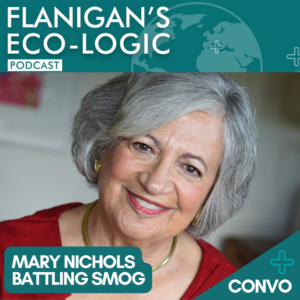
In this episode of Flanigan’s Eco-Logic, Ted speaks with Mary Nichols, who served as the chair of the California Air Resources Board (CARB) for a total of 18 years. Mary is widely recognized for a career as one of the world’s most important environmental regulators. Over a career as an environmental lawyer spanning over 45 years, she has played a key role in California and the nation’s progress toward healthy air.
She and Ted discuss her background receiving her J.D. from Yale Law School, devoting her career to fighting air pollution for then on. She shares that her interest in the environment came about as a result of having been involved in the Civil Rights and Anti-War movements, believing in the need for activism at the community level. After law school, she worked as an attorney for the Center for Law in the Public Interest in Los Angeles where she brought the first litigation under the then recently passed Clean Air Act.
During her leadership at the CARB, California became a national leader at developing clean energy and clean transportation solutions that many other states and nations have adopted. She shares with Ted that her current climate-related work is focused in China, travelling there twice a year in her capacity as a member of the board of The Energy Foundation.
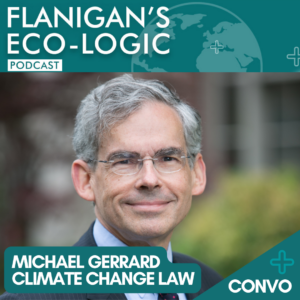
In this episode of Flanigan’s Eco-Logic, Ted speaks with Professor Michael Gerrard from Columbia University. He is the founder and faculty director of the groundbreaking Sabin Center for Climate Change Law, and one of the foremost environmental lawyers in the nation. Michael is an advocate, litigator, teacher, and scholar who has pioneered cutting-edge legal tools and strategies for addressing climate change. He writes and teaches courses on environmental law, climate change law, and energy regulation. He was the chair of the faculty of Columbia University’s renowned Earth Institute from 2015 to 2018 and now holds a joint appointment to the faculty of its successor, the Columbia Climate School.
Before joining the Columbia Law School faculty in 2009, Michael practiced law in New York for three decades, most recently as the partner in charge of the New York office of Arnold & Porter. As an environmental lawyer, he tried numerous cases and argued many appeals in federal and state courts and administrative tribunals. He also handled the environmental aspects of diverse transactions and development projects and provided regulatory compliance advice to an array of clients in the private and public sectors.
He highlights some of his most impressionable career cases, and shares that he is currently leading a legal effort to sue the Governor for New York, Kathy Hochul, for indefinitely pausing the rollout of congestion pricing in New York City. He also shares with Ted his work with the government of the Republic of the Marshall Islands on the legal issues caused by rising sea levels that threaten the island nation.
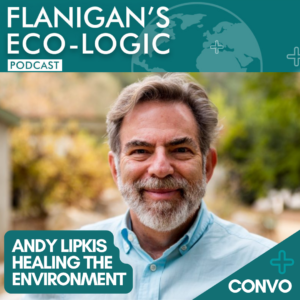
In this episode of Flanigan’s Eco-Logic, Ted speaks with Andy Lipkis, Founder of TreePeople, who served as President for five decades. He is currently a Project Executive at Accelerate Resilience LA (ARLA). Andy is a pioneer of urban and community forestry, urban watershed management, and urban climate resilience, dedicating his life to healing the environment while improving the lives of individuals and communities.
Andy grew up in southwest LA and began planting trees to rehabilitate smog and fire damaged Los Angeles–area forests when he was 15 years old. At 18, he founded TreePeople, bringing together people, trees, and forest-inspired ‘green infrastructure’ to protect cities against droughts and floods, prevent water and air pollution, and mitigate and adapt to climate change. TreePeople’s work in LA provided a model for environmental, economic, and social sustainability in cities everywhere. He created a greener future for Los Angeles by inspiring people, along with their local governments, to plant and care for trees and harvest and conserve the rain. Since its founding, TreePeople volunteers have been responsible for the planting of more than 2 million trees and counting. Its environmental education program reaches more than 200,000 students per year, with millions of children touched over the decades.
With climate change impacts already creating a chronic emergency for cities around the world, Andy’s work has demonstrated promising new ways for individuals, communities and government agencies to collaboratively reshape urban tree canopy and water infrastructure to save lives and grow a more livable future.
After retiring from TreePeople in 2019, Andy launched Accelerate Resilience LA, a fiscally sponsored project of Rockefeller Philanthropy Advisors to inspire and enable people and local governments to equitably accelerate climate resilience in Los Angeles. He shares with Ted that his personal mission is to inform, inspire, engage, and support people and communities to participate in restoring the healthy functioning of an ecosystem so it can abundantly provide life support services. He highlights the power of individuals and communities to make a positive impact, and the great need that exists to heal our environment.
